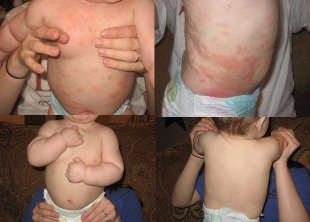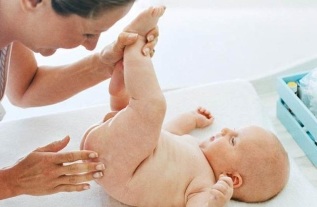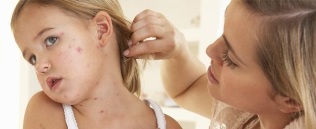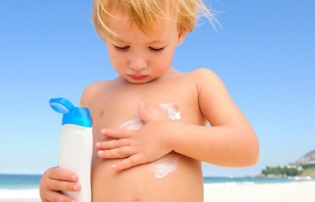Psoriasis in children is diagnosed at any age. It is a chronic disease that can affect even infants and newborns, in the last few years have seen an increase in cases of psoriasis is an infant / preschool children. The appearance of the first signs of the disease, it is necessary to initiate a comprehensive treatment. The earlier you can get the status of the receipt of the referral, the better for the health of the baby.

The causes of the appearance of the psoriasis children
Child psoriasis systemic. Your development make the breach in the functioning of the immune system, when the body can not resist the harmful effects of external factors.
The doctors can not distinguish a single cause, a cause the appearance of the disease in the child. But there are a number of scientific assumptions:
- Hereditary predisposition – if the family has been diagnosed cases of psoriasis, the likelihood of developing in the child increases by 30%. When this disease affects both parents, it increases to 80%. But it is inherited, only the predisposition to the disease and, therefore, with the proper care of the child, there is the possibility to avoid the problem.
- The violation of the activities of the nervous system – the negative experiences, stress, sudden changes in life (change of school, the birth of her second child) can induce the onset of the disease.
- Violations of the processes of change – deficit of vitamins, trace elements.
- The presence of parasites – helminths to absorb nutrients, they emit a large amount of toxins, that adversely affect the body of a child. Often appear reactions in the skin, psoriasis.
- The childhood infections, psoriasis usually appear after transfer of infectious diseases. Can cause sore throat, flu, colds.
- The dysfunction of the endocrine system – hormonal imbalance causes the psoriasis.
- Disease of the liver – in the case of infringements in the work of that body, the body is unable to neutralize toxins, which can be the development of psoriasis. Often the psoriasis in children the first time that is diagnosed in the cold season of the year. Greatly increases the risk of its development, and lesions of the skin.
The symptoms of psoriasis in children

Signs of psoriasis in infants are significantly different from the symptoms of this disease in the adult. The children in the initial stage appear red in precipitation in the folds of the skin (in the gluteal region, the axilla (armpit), in the head, face, genitals. It is also located in the areas subjected to continuous friction from clothing. Rarely rash occurs on the palms of the hands and feet. The eruption reminds intertrigo, but it has the main symptom of psoriasis – hot ball of papules exfoliate, appears flaking. Little by little, the delicate skin is covered by a layer of return-cobalt. Isolated small nodules fuse into conglomerates. Its size gradually increases, covering large areas of the epidermis. In the majority of cases, the eruption of the itch, bringing the child a huge upset. Comb papules, at the risk of becoming infected.
The baby stage of psoriasis and their symptoms
- Progressive – the appearance of the small red rash or bright pink. She was itching, scaly, increase in size and applied on the skin. Soon the eruption is covered with cracks, it starts to bleed a little. Unlike adults, children almost does not exist the phenomenon of stearic spots, terminus of a movie. Severe, progressive stage, the child increases the temperature of the body, compacted the surface of the epidermis, increase the lymph nodes, they observed swelling of the skin, redness constant.
- Fixed – formation of new rashes, and their growth ceases, it reduces the intensity of the peeling.
- Regressive – a rash begins slowly dissolvere. After his disappearance on the skin appear depigmented tires.
The complete disappearance of the signs of the disease come out of remission. Its duration depends on the specific characteristics of the care of children, in particular of the diet. The relapse of the disease in children often becomes the result of the transfer of infectious diseases.
Children psoriasis
Distinguish different types of psoriasis in children. Are classified depending on the characteristics of the symptoms and the location of eruptions. The main forms of the disease:
- Libero psoriasis. Appears in children under the age of one year. The rash is located mainly in the area of the gluteus maximus. Due to the constant contact with urine and faeces, in consequence rub diapers skin in this area becomes irritated, therefore, the disease is difficult difficult to to diagnose. Parents often have this rash for dermatitis, what prevents you from starting the treatment.
- Tabula (normal) psoriasis. The most common form of the disease in children. Your specific symptoms on the surface of the skin forming red spots. First are small, but with enough speed increase in diameter, they begin to flake. The base of the papules has a dense texture. Above are covered pasty layer of scales, which separate easily. Are located Tabula papules on different parts of the body, but most often occur in the zone of flexion of the elbows and knees, the scalp.
- The guttate psoriasis. The body is covered by a great number of eruptions, which by the way they look, such as gout, have a small size and a convex form. The papules are elevated above the surface of the epidermis and cortices. Cover the head, hands and feet, as well as the trunk. The rash may disappear independently, or to become a tabula psoriasis. At the age of 4-5 years, this form of the disease is streptococcal infection.
- Generativus pustular psoriasis. Develops suddenly and very fast. For a short period of time large areas of the skin that are inflamed, are covered by the ulcer. Affected area of the epidermis hurt. This form of psoriasis is dangerous causing serious complications. It can lead to disease of the internal organs, in particular kidneys, the heart.
- the pustular psoriasis.It affects children older than 7 years. In infants and preschool-aged children is rare. This is a severe form of the disease, in which there is swelling of the skin, and its surface is covered by bubbles, filled with non-communicable exudo. Often accompanied by inflammation of the lymph nodes.
- Erythrodermic psoriasis. It is very dangerous the way, provocaverunt praesent thermoregulation of the body. It is manifested in generativus inflammation of the epidermis, the intense pursuit of the peeling. Is accompanied by itching, painful sensations. Enlargement of the area of the skin start to peel off. Can cause death, especially if the child is small.
- Psoriasis of the bending of the surfaces. Appears in the folds of the body, often in the inner zone of the thigh, the groin, the genitals. The body is covered in red spots. Are smooth and not cortices, but a little convex.
- Arthropathic psoriasis. Affects the joints. The signs of this form of the disease – muscle stiffness, cease to be mobile, the joints and fingers are swollen and swollen. The knees, fingers, ankles, wrists sore, there is a general feeling of malaise. You can appear conjunctivitis. For the current type of psoriasis is divided into types: winter or summer – regardless of the season, when there is a relapse, the majority of children of the winter of the way; the first time that arose when the symptoms appear for the first time; continually recurring is the constant worsening of the disease; indefinitely.
- Psoriasis of the nails. Surprise clavum of the plate. Your symptoms depend on the form. We distinguish the following varieties:
- naperstkovidnym – on the surface of the nails are formed of small depth, so that visually you are turning in a thimble;
- nicomedes – nails, exfoliation of the lodge very quickly;
- onycholysis – nail to slowly peel of the lodge, with inflammatory processes are missing around the base of the nail appears a border of yellow-pink color;
- trachyonychia – nail thickens, becomes rough, its surface area becomes in the form of a wave, the edge is raised;
- hemorrhaging subungual – beneath the surface of the nail streaking and stains red-pink;
- paronychia psoriatic – skin around the nail and the finger thicken, this is accompanied by intense inflammatory processes.
The diagnosis of psoriasis in child
The diagnosis of psoriasis is made the doctor dermatologist. Performed the review of the child, accurate, when they appeared rashes, as manifested the disease, if there is in the nature of people who suffer from this disease. To establish a diagnosis of children, especially in children under 1 year, exclusively, by visual inspection is difficult, because often no classic symptoms of the disease: stearic stain, a terminal film, and "blood in the mist". Exactly make sure that you have psoriasis will enable the analysis of scrapings, taken from the surface of rashes.
The treatment of psoriasis in children

Children, sufferers of psoriasis, they need to combined treatment. Quickly get the state of the remission of the help of system of the therapy, at the time led to the elimination of symptoms and strengthen the body in general. Let's see the main methods of treatment.
Medicines for external use
Are effective for the solution of papules, hit the skin. This group will include:
- salicylic ointment 1-2% - should not be given to infants;
- sulphur-tar ointment 2-3%; boric ointment.
- glucocorticoid ointment 0.5% – "Locacorten", "Flucinar", "Prednisolone";
- the inhibitors of the phosphodiesterase – papaverine ointment 1% and teofillina ointment 5% for the treatment of psoriasis, the hit pilosus the part of the head;
- steroid creams and ointments – "Instructio", "Haec solutio" and other ointments of psoriasis;
- heparin ointment for long-standing of platelets.
Medicines for internal use:
- desensitizing tools – three times on the day the sample is taken a solution of calcium gluconate 5% of the ladle, tea-duration specifies the doctor;
- sedatives – to the children of the tincture of valerian;
- antihistamines to relieve the itching – 7-10 days take the "Tavegil", "Suprastin", in acute conditions, are introduced to the injections, the more easy – you can prescribe the pill;
- tranquilizers in rare cases, they are the older children, you can apply the "Tazepam", "Seduksen";
- vitamins to strengthen the immune system – folic acid, vitamin b12, 15, D, A, E, drink three times a day for a couple of months;
- pyrogenic drugs to activate the protective functions of the body, the normalization of the permeability of the vessels, is prescribed 8-10 injection "Pirogenala", children older than 3 years;
- glucocorticoids appointed in serious cases, the course of 2-3 weeks with a gradual decrease of the dose.
Proper nutrition
For as quickly as possible to cure psoriasis and to achieve a state of remission, it is necessary to observe the mode of feeding:
- exclude from the diet cakes, buns, sweets, fatty and fried cooking, chocolate;
- limit the intake of citrus fruits;
- drinking sufficient amount of liquids;
- replace sweet drinks and herbal tea;
- the basis of the diet of green leafy vegetables, recenter juices, dietary meat, lean fish.
The prevention of the

To minimize the risk of the disease and prolong the period of remission, follow the simple rules:
- during the bath, do not use aggressive media and hard sponge;
- teach the child to avoid cuts, burns, injuries of skin; avoid the child's contact with the skin in direct sunlight;
- prefer clothing of natural fabrics, pay attention to the diet of a child; carefully choose the essential drugs;
- concerned that the child was a positive emotional state.
When there is minimal suspicion that the child appeared psoriasis, see your dermatologist. It is a serious disease, therefore, how to treat it can say only competent doctor. Not-self, because the sooner it is past, it is a good therapy, the faster that you can reach the state of receipt of the referral. Despite the fact that the psoriasis there is no cure, the correct and timely approach, you can reduce the number of relapses of the disease.























